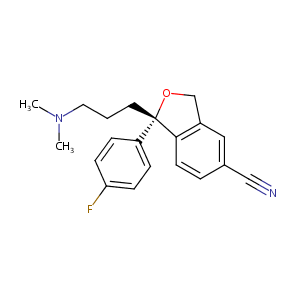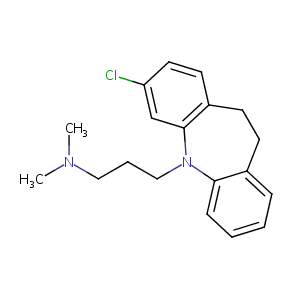| 1 |
ClinicalTrials.gov (NCT01404871) Predicting Medication Response in Obsessive Compulsive Disorder
|
| 2 |
Drugs@FDA. U.S. Food and Drug Administration. U.S. Department of Health & Human Services. 2015
|
| 3 |
URL: http://www.guidetopharmacology.org Nucleic Acids Res. 2015 Oct 12. pii: gkv1037. The IUPHAR/BPS Guide to PHARMACOLOGY in 2016: towards curated quantitative interactions between 1300 protein targets and 6000 ligands. (Ligand id: 2398).
|
| 4 |
Clomipramine FDA Label
|
| 5 |
Antidepressants and sleep: a review. Perspect Psychiatr Care. 2009 Jul;45(3):191-7.
|
| 6 |
PharmGKB summary: citalopram pharmacokinetics pathway. Pharmacogenet Genomics. 2011 Nov;21(11):769-72.
|
| 7 |
CYP2D6 P34S Polymorphism and Outcomes of Escitalopram Treatment in Koreans with Major Depression. Psychiatry Investig. 2013 Sep;10(3):286-93.
|
| 8 |
Escitalopram pharmacogenetics: CYP2C19 relationships with dosing and clinical outcomes in autism spectrum disorder. Pharmacogenet Genomics. 2015 Nov;25(11):548-54.
|
| 9 |
Serotonin transporter promoter region polymorphisms do not influence treatment response to escitalopram in patients with major depression. Eur Neuropsychopharmacol. 2009 Jun;19(6):451-6. doi: 10.1016/j.euroneuro.2009.01.010. Epub 2009 Mar 9.
|
| 10 |
A toxicogenomic approach to drug-induced phospholipidosis: analysis of its induction mechanism and establishment of a novel in vitro screening system. Toxicol Sci. 2005 Feb;83(2):282-92.
|
| 11 |
Efficacy of treatments for patients with obsessive-compulsive disorder: a systematic review. J Am Acad Nurse Pract. 2009 Apr;21(4):207-13.
|
| 12 |
Improving the prediction of the brain disposition for orally administered drugs using BDDCS. Adv Drug Deliv Rev. 2012 Jan;64(1):95-109.
|
| 13 |
ADReCS-Target: target profiles for aiding drug safety research and application. Nucleic Acids Res. 2018 Jan 4;46(D1):D911-D917. doi: 10.1093/nar/gkx899.
|
| 14 |
Clinical pharmacogenetics implementation consortium guideline (CPIC) for CYP2D6 and CYP2C19 genotypes and dosing of tricyclic antidepressants: 2016 update. Clin Pharmacol Ther. 2017 Jul;102(1):37-44. doi: 10.1002/cpt.597. Epub 2017 Feb 13.
|
| 15 |
Hepatocellular peroxisomes in human alcoholic and drug-induced hepatitis: a quantitative study. Hepatology. 1991 Nov;14(5):811-7.
|
| 16 |
Glutathione S-transferase pi as a target for tricyclic antidepressants in human brain. Acta Biochim Pol. 2004;51(1):207-12.
|
| 17 |
Determination of phospholipidosis potential based on gene expression analysis in HepG2 cells. Toxicol Sci. 2007 Mar;96(1):101-14.
|
| 18 |
Inverse agonist and neutral antagonist actions of antidepressants at recombinant and native 5-hydroxytryptamine2C receptors: differential modulatio... Mol Pharmacol. 2008 Mar;73(3):748-57.
|
| 19 |
Antidepressant drugs activate SREBP and up-regulate cholesterol and fatty acid biosynthesis in human glial cells. Neurosci Lett. 2006 Mar 13;395(3):185-90. doi: 10.1016/j.neulet.2005.10.096. Epub 2005 Dec 1.
|
| 20 |
Neuroendocrine responsivity to clomipramine challenge test in neuroleptic naive psychotic patients before and after treatment with haloperidol. Eur Psychiatry. 1997;12(7):362-6. doi: 10.1016/s0924-9338(97)80006-5.
|
| 21 |
Reversible acute renal failure associated with clomipramine-induced interstitial nephritis. Clin Exp Nephrol. 2007 Sep;11(3):241-243. doi: 10.1007/s10157-007-0485-4. Epub 2007 Sep 28.
|
| 22 |
The antidepressants imipramine, clomipramine, and citalopram induce apoptosis in human acute myeloid leukemia HL-60 cells via caspase-3 activation. J Biochem Mol Toxicol. 1999;13(6):338-47. doi: 10.1002/(sici)1099-0461(1999)13:6<338::aid-jbt8>3.0.co;2-7.
|
| 23 |
Palmitate increases the susceptibility of cells to drug-induced toxicity: an in vitro method to identify drugs with potential contraindications in patients with metabolic disease. Toxicol Sci. 2012 Oct;129(2):346-62. doi: 10.1093/toxsci/kfs208. Epub 2012 Jun 14.
|
| 24 |
Association of CYP1A1 and CYP1B1 inhibition in in vitro assays with drug-induced liver injury. J Toxicol Sci. 2021;46(4):167-176. doi: 10.2131/jts.46.167.
|
|
|
|
|
|
|


